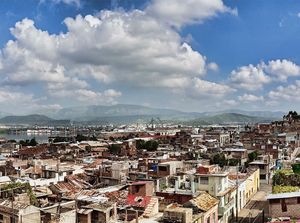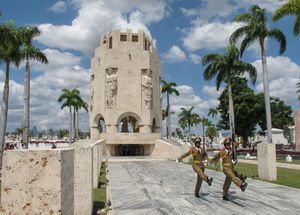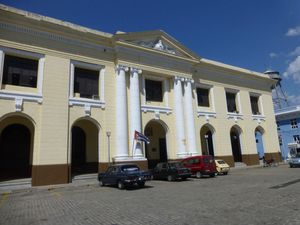

Santiago de Cuba, Cuba
Discover the historical city of Santiago de Cuba and walk through its legendary strrets with its wonderful people.
Santiago de Cuba is the second most important city in this Caribbean country. It is located in the south of the island and has witnessed historical events along since the times of the Spanish colonization.
Founded in 1515 by the Spanish conqueror Diego Velázquez, the city keeps several places that remind of the period that changed the direction of the history of the island. Other important periods are reflected in the mark that they left on the architecture, art and traditions of the people of Santiago.
In this wonderful city you can visit the Museum of the Historical Cuban Atmosphere, located next to the Céspedes Park and very near the Nuestra Señora de la Asunción Cathedral. You can also visit the Velázquez Balcony and the Casa Diego Velázquez House to know more about the colonial period.
Besides, the city has a privileged location in the Santiago de Cuba Bay, which allowed it to be the first country’s capital during a short time. Through it, the first black slaves arrived to Cuba and, with them, their traditions still kept and maintained in places like Casa del Caribe House and the Casa de las Religiones Populares House.
Along with the bay, the relief of the area gives a lot of opportunities to enjoy wonderful landscapes while doing activities related to the ecologic and mountain tourism. This way, you can see the incredible landscape of the Caribbean Sea from the Pico Turquino Summit, the green views you can see from the Gran Piedra or the beautiful images of the Santiago de Cuba Bay from the Cayo Granma Cay or the Castillo de San Pedro de la Roca Castle, declared World Heritage Site by the Unesco in 1997.
For centuries, this city has seen the different struggles for the Independence of the country, as well as the Revolution, the most important event of the second half of the 20th century in the island. Known as the Hero City of Cuba, moving locations were built to remember to all those persons who fought in every single decisive clashes. In this way, you can visit the Cementerio Santa Ifigenia Graveyard, where several heroes from Santiago de Cuba are buried next to monuments that remind their deeds.
Furthermore, the city uses the extended tradition of dedicating squares and parks to important celebrities from Cuban history. You can visit a series of beautiful open spaces like the Céspedes Park, the San Juan Historical Park and the Peace Tree or the Abel Santamaría Historical Park, which are the perfect place to have a break and let oneself go by the atmosphere of the city while seeing the most important monuments.
Santiago de Cuba is an incredible city formed by impressing landscapes, interesting historical buildings, streets full of life and color bursting with culture and traditions, memories of past times that come to meet you in every corner and kind people whose roots are spread throughout the world.
The religion has also an important place in the culture of the island, and that is the reason why many of the most interesting buildings are related to it. During your stay in Santiago de Cuba, you can visit the different churches that constitute the historical and architectonic heritage for the future generations. Among the most interesting temples, you can see the Nuestra Señora de la Asunción Cathedral, the Iglesia de Nuestra Señora de los Dolores Church and the Iglesia de San Francisco Church.
The Cuban Revolution was a historical moment of great importance for the whole island, although this area lived it with a special intensity. This city was the chosen place for the uprising of 1953. That struggle was led in three phases directed by Fidel Castro, Abel Santamaría and Raúl Castro, who attacked the Cuartel Moncada Headquarters, the Civil Hospital and the Justice Palace. Although this action didn’t success, it was the beginning of the process which overthrew the Batista Regime. The fight ended after two and a half years of guerrilla struggles, between the Desembarco del Granma Landing in 1956 and 1959 when the Revolution defeated the regime.
If you are interested in that part of the history of Cuba, there are several places that still remind and show this important Cuban moment. From the Museum of the Clandestine Struggle, the Plaza de la Revolution Square or the Frank and Josué País House Museum, until the Granjita Siboney Museum in the outskirts of Santiago de Cuba, and the Modelo Presidium, located in the Isla de la Juventud, they are just some of the places where facts related to the Revolution are explained by means of exhibitions of the objects of that period.
In the area surrounding Santiago, you will find countless places in which you can make all kind of activities, like hiking, climbing, camping and many other more. Enjoy all of these activities surrounded by the breathtaking beauty that nature has granted to the different national parks that protect the area. It is worth the effort to tour the Turquino National Park, or the Gran Piedra National Park, and enjoy the wonderful landscapes that the Baconao National Park offers us.
You can also find a tropical paradise in any of the abundant beaches that are bathed by the Caribbean sea and that are located along the coast of the zone. You cannot miss the Playa Baconao Beach, the Playa Cazonal Beach or the Carisol International Diving Center-Los Corales to do all those water activities you like, i.e. diving, or just to relax and enjoy the white sands and crystalline waters of the Caribe.
In the province, you can also discover lovely localities near the city, like El Cobre, El Oasis and Chivirico, among a long list of interesting villages; or live the vibrant Cuban night in the streets of Santiago de Cuba, in mythical places like the Calle Heredia Street or the Casa de la Trova House, where the music sounds the whole night.
Interactive map:
Santiago de Cuba
What to see:
- Céspedes Park
- Calle Heredia Street
- Nuestra Señora de la Asunción Cathedral
- Velázquez Balcony
- Casa de la Trova
- Model of the City
- Plaza de Dolores Square
- Iglesia de Nuestra Señora de los Dolores Church
- Plaza de Marte Square
- Provincial Government Palace
- Tívoli
- Escalinata Padre Pico Highway
- Cuartel Moncada Headquarters
- Plaza de la Revolución
- Pioneers’ Palace
- La Gran Piedra
- Cumbre La Gran Piedra Summit
- Cafetal La Isabelica Coffee Plantation
- Parque Baconao
- Baconao Aquarium
- Baconao Lagoon
- Granma Cay
- Siboney
- El Cobre
- Nuestra Señora del Cobre Basilica
- Chivirico and its Vicinity
- Pico Turquino Peak Area
- Pico Turquino
Beaches:
Museums:
- Museum of Historical Cuban Atmosphere
- Archdiocesan Museum
- Municipal Museum Emilio Bacardí Moreau
- El Carnaval Museum
- Rum Museum
- Clandestine Fight Museum
- Casa-Natal de Antonio Maceo Birth House Museum
- Abel Santamaría Historic Park
- San Juan Historic Park and the Peace Tree
- Cemetery of Santa Ifigenia
- Castle of San Pedro de la Roca del Morro
- Granjita Siboney Museum
- Spanish-Cuban-American War Museum
- Prehistory Valley
- Monument to Cimarrón
Other nearby destinations:
Why "Trip Cuba"?
Trip Cuba is an organization of Cuban agencies whose objectives are:
- ✓ To make Cuba, its culture and its heritage known.
- ✓ To promote sustainable tourism.
- ✓ To support the local economy, prioritizing direct contact with Cuban agencies.
Travel Agencies
If you are a travel agency or tour operator and you are looking forward to any assistance or collaboration to plan trips to Cuba, rely on our extensive experience
Copyright www.TripCuba.Org © - All rights reserved
All our agencies are duly registered in the National Registry of Travel Agencies of the Chamber of Commerce of the Republic of Cuba.










